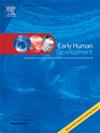重复药物治疗早产儿动脉导管未闭的疗效
IF 2.2
3区 医学
Q2 OBSTETRICS & GYNECOLOGY
引用次数: 0
摘要
背景反复用药对早产儿动脉导管未闭(hsPDA)闭合或收缩血流动力学意义重大的有效性尚未得到广泛研究。我们的目的是评估在107名胎龄婴儿中使用布洛芬和/或扑热息痛进行第二或第三疗程治疗的有效性。29周。方法超声心动图诊断为hsPDA的婴儿在出生后24 ~ 72 h分别给予布洛芬、扑热息痛或布洛芬加扑热息痛治疗。在每个药物疗程结束时重复超声心动图检查。结果第一、二、三疗程药物治疗失败率分别为38%(41/107)、76%(31/41)、92%(24/26)。在24例治疗失败的婴儿中,8例(31%)在3个疗程后hsPDA闭合或收缩,15例(57%)手术闭合,3例(12%)死于hsPDA。Logistic回归分析没有显示第二和第三疗程治疗失败的独立危险因素。结论第二、三疗程药物治疗失败率高于文献报道。在失败率很高的中心计划第三次和额外的药理学课程可能会延长极早产儿暴露于hsPDA的不良影响。本文章由计算机程序翻译,如有差异,请以英文原文为准。
Effectiveness of repeated pharmacological courses for patent ductus arteriosus in preterm infants
Background
The effectiveness of repeated drug course to close or constrict a hemodynamically significant patent ductus arteriosus (hsPDA) in preterm infants has not been studied extensively. Our aim was to assess the effectiveness of a second or third course of treatment with ibuprofen and/or paracetamol in 107 infants with gestational age < 29 weeks.
Methods
Infants with echocardiographic diagnosis of hsPDA were treated with ibuprofen, paracetamol, or with ibuprofen plus paracetamol between 24 and 72 h of life. Echocardiography was repeated at the end of each pharmacological course.
Results
The failure rate of the first, second and third course of drug treatment was 38% (41/107), 76% (31/41), and 92% (24/26), respectively. Among 24 infants who failed treatment, 8 (31%) had closure or constriction of the hsPDA after >3 drug courses, 15 (57%) received surgical closure, and 3 (12%) died with hsPDA. Logistic regression analyses did not show independent risk factors for the failure of the second and third course of treatment.
Conclusions
We found a higher failure rate of the second and third courses of drug treatment than previously reported. Planning the third and additional pharmacological courses at centers where the failure rate is very high may prolong the exposure of very preterm infants to the adverse effects of hsPDA.
求助全文
通过发布文献求助,成功后即可免费获取论文全文。
去求助
来源期刊

Early human development
医学-妇产科学
CiteScore
4.40
自引率
4.00%
发文量
100
审稿时长
46 days
期刊介绍:
Established as an authoritative, highly cited voice on early human development, Early Human Development provides a unique opportunity for researchers and clinicians to bridge the communication gap between disciplines. Creating a forum for the productive exchange of ideas concerning early human growth and development, the journal publishes original research and clinical papers with particular emphasis on the continuum between fetal life and the perinatal period; aspects of postnatal growth influenced by early events; and the safeguarding of the quality of human survival.
The first comprehensive and interdisciplinary journal in this area of growing importance, Early Human Development offers pertinent contributions to the following subject areas:
Fetology; perinatology; pediatrics; growth and development; obstetrics; reproduction and fertility; epidemiology; behavioural sciences; nutrition and metabolism; teratology; neurology; brain biology; developmental psychology and screening.
 求助内容:
求助内容: 应助结果提醒方式:
应助结果提醒方式:


